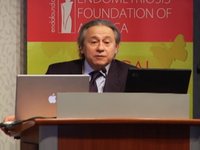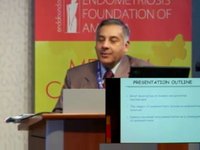I think the applause goes back to you from me. Thank you really, indeed, for coming here today. I know many of you came from very long distances and cancelled your schedules for this, from Australia to Oregon to Italy, I cannot name them all. The bottom line is, most importantly, thank you for all the patience that has made this possible.
As students of endometriosis I welcome you. We are learning. This disease is humbling every one of us every day. That is why we are here today, we are here to exchange ideas, opinions and most importantly we want to lock into the science of endometriosis, which guides the surgeons on what to do to help the patients. We have years to go. The foundation is a baby, however I am happy to announce to you that we are being noticed and today, at this meeting, even though there are not too many people here yet, they are coming. This is live on internet and we like to open the doors to all.
With that I would just like to briefly tell you why we named this “Sex and Endometriosis”. As you know, sex is an important part of life and it is very little discussed. The eventual physiology of pain with sex involves the ultimate depth of the vagina, which is intact with the internal peritoneal cavity, which is the cul-de-sac really. And the cul-de-sac is traditionally named as basically the end-point of the peritoneal cavity in a standing position. It happens to be the collection place for menstrual debris or inter-operative artifacts. This area involves multi-organ association with the vagina, reproductive organs, uterus, ovaries and tube, ureters and bowels.
The reason why endometriosis probably gets lost is because it is a disease and eventually the center of it is in this cul-de-sac. Even though there are the ovaries and peritoneal in the end this is the area that is most neglected during surgical procedure. It is a very thin membrane; it is probably less than 5mm and you can transilluminate very easily. These are some pictures I have taken, mini-gland you may call it, and it is bleeding and a little symbol of the cul-de-sac. Anatomical it can extend and accommodate almost the whole baby during delivery, right? And this is what happens during sex with a patient with endometriosis when there is disease there. And you do not treat the disease there, they cannot treat the disease, this is where the problem comes from. The cervix gets involved, the rectum gets involved and many times hysterectomy is not a solution. Bowel resection is not a solution.
This week alone I have seen five patients with multiple loop bowel resections, with the uterus taken out but there is still disease there. This is why we are here today and this is how we named this meeting, first ever to focus on sex as a physiology coming from the symptoms, to look at this aspect of the disease.
Thank you for coming and we are going to start with the first presenter. The first section will be science. Then we will talk about the social aspect of how endometriosis affects personal life, families and why we get lost. Then the surgeons will speak.
Thank you.









